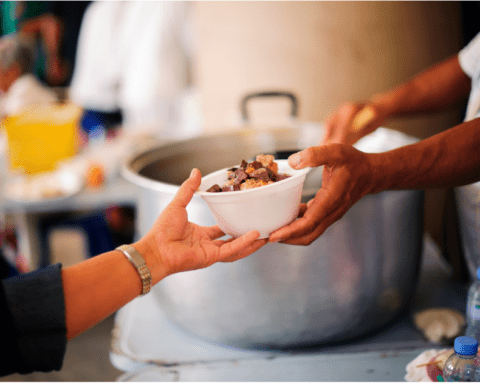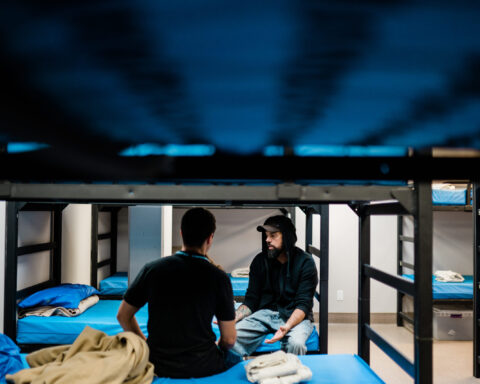Tucked behind Toronto City Hall’s curved towers, on Elizabeth Street, is a modest patch of greenery outfitted with bright red benches and blossoming tulips. It’s from this spot — once a parking lot— that historian Arlene Chan reconstructs an image of Toronto’s first Chinatown.
Chan draws on a mix of personal history and research to inform her audience, who joined her Heritage Toronto tour of Old Chinatown on May 14. A librarian turned writer, Chan offers a glimpse into the lives of the city’s early Chinese immigrants.
“Why was there a Chinatown? Why was there such a tight-knit community?” asks Chan, before answering her own question. “It was because the Chinese were isolated. ”
Chinatown emerged out of necessity, with different associations providing social services, whether it came to finding a place to live or borrowing startup capital for their business, she says.
The origins of Toronto’s Chinatown
Today’s Elizabeth Street bears little resemblance to the lively stretch it had been in the 1930s. Gone are the streetcar tracks, the destination restaurants and the Chinese-owned laundry services that made it Chinatown’s first core.
Chan takes the tour group through several stops, starting with Old City Hall, where she points to the pillars carved with faces of municipal politicians and immigrants — including the Chinese — and then coming full circle at New City Hall.
The area and its surroundings (known as The Ward) was from the 1840s to the Second World War, a gateway community for Toronto’s new arrivals. Successive waves of immigrant communities— Jews, Poles, Italians and the Irish—all passed through.
“You live here, you’ve worked here all your life, but you’re not a citizen.”
Up until the end of the Second World War, the movement of Chinese immigrants in and out of the country had been regulated—first with prohibitive head taxes and then with documents called CI-9s, head tax certificates that were one of the first pieces of photo IDs in Canada.
“They were passports before passports were introduced,” says Lily Cho, professor at York University, in an interview. “These were documents explicitly used to identify people who weren’t given the rights of citizenship. You live here, you’ve worked here all your life, but you’re not a citizen.”
When the Exclusion Act, which banned immigration from China, was repealed in 1947, so too were CI-9s.
Canada’s adoption of the immigration point system in 1967 enabled Hong Kong entrepreneurs to invest in Chinatown at Dundas.
Redevelopment threatens historic Chinatown
But by the 1940s, the City of Toronto began eyeing the land as a crucial site for redevelopment, the linchpin for its plans to build a new city hall and civic square. Not only was it in close proximity to the seat of government, but The Ward was also considered a slum.
Media reports depicted an unsavoury climate riddled with crime and prostitution, an area dotted with overcrowded tenements and ramshackle storefronts.
“The Ward was considered an undesirable place; it had a bad reputation,” says Chan.
The City expropriated two-thirds of Chinatown, forcing property owners to disperse or relocate their business to Dundas and Spadina streets, explains Chan.
“The Ward was considered an undesirable place; it had a bad reputation.”
“They moved to establish their new buildings and facilities nearby, but that destroyed a lot of significant landmarks,” says Jack Leong, director of the Hong Kong-Canada library at the University of Toronto, in a separate interview.
By then, about 55 per cent of the property in Chinatown was Chinese-owned, says Chan. “People who had paid a certain amount for the real estate were not fairly compensated. They didn’t get fair market value for the land.”
What remained was a strip of unremarkable storefronts and forgettable restaurants, with little hint of its significance as the site where most Chinese immigrants settled into their new life.
The fight to save Chinatown
Seen through Chan’s eyes, Elizabeth Street looms large in the imagination. It’s where her parents, Jean and Doyle Lumb, opened their famed establishment, Kwong Chow restaurant. It’s also the last frontier on which the fight to preserve Chinatown was waged.
Together with other community leaders, Jean organized the Save Chinatown Committee in 1967.
The campaign mobilized in response to the city’s intention to acquire what was left of Chinatown. Council ultimately decided to preserve what was left, which also allowed Chinatown to be extended to where it is now, says Chan.
“My strong feeling was that it was [actually] because of four restaurants that opened after the Second World War,” she says. “[They] were dramatically different than restaurants in Chinatown earlier—the pre-World War II restaurants were very small, had a very limited menu and catered to the Chinese clientele.”
The “big four” restaurants, Sai Woo, Kwong Chow, Nanking and Lichee Garden, fashioned themselves as classy restaurants that accommodated large parties, offered a Canadian take on Chinese food and provided musical entertainment.
Chinatown also began offering tours around the neighbourhood, which wrapped up with a meal at one of these restaurants.
“All of the owners were prominent members of the Chinese community,” explains Chan. “Because of their leadership and interactions with Canadian society – politicians, celebrities started going to these restaurants. It turned people’s opinions.”
“Chinatown will endure because it knows how to adapt to survive.”
Today’s Chinatown is still bound together by a shared culture and similar values, notes Leong. But Chan and Leong say that Chinatown is always in a state of flux.
Condos have steadily sprung up on the south end of Spadina, notes Chan, along with new restaurants catering to the younger crowd seeking a modern take on Chinese cuisine. Such developments don’t concern Chan, who says Chinatown will endure because it knows how to adapt to survive.
“It’s constantly changing because the community has adapted as things are happening,” says Chan. “[The change] is going to take a while. It’s going to become a hipper part of the city; it’s going to reinvent itself again.”
Beatrice Paez is the digital editor at The Hill Times in Ottawa.





